Wildfires have returned to the Western Canadian Sedimentary Basin (WCSB) after a brief rain-related respite late last week, forcing Canadian shale operators to temporarily shut in production across northwestern Alberta.
As of the afternoon of 16 May, high-confidence outage volumes based on operator communication stand at about 240,000 barrels of oil equivalent per day (boepd), although in reality, the impact is likely in excess of 300,000 boepd if not higher.
In addition to lingering out-of-control (OC) wildfires in west central and northwestern Alberta, Rystad Energy estimates nearly 2.7 million barrels per day (bpd) of oil sands production in northeastern Alberta in ‘very high’ or ‘extreme’ wildfire danger rating zones, posing yet another risk to Western Canadian supply should conflagrations extend beyond their current areas.
Since 12 May, operators have shut-in approximately 240,000 boepd primarily in the Montney and Duvernay plays.
Paramount Resources and Crescent Point Energy lead in terms of announced impacts, with both operators indicating 45,000 boepd in shut-ins at Wapiti and Kaybob since 12 May (Figure 1).
Similarly, on 15 May Chevron shut in its Duvernay production at Kaybob, with an estimated impact of nearly 60,000 boepd based on March 2023 production volumes.
Meanwhile, Baytex Energy increased its outage volumes from 10,000 boepd to 24,000 boepd effective 13 May, with approximately 20,000 boepd stemming from heavy oil production at Peavine and Peace River and the balance centered at its west-central Alberta assets.
At Grande Prairie, Montney pureplay Pipestone Energy increased its outage volume back to 20,000 boepd owing to third-party infrastructure constraints, while Kiwetinohk Energy announced an impact of nearly 20,000 boepd from shut-ins at its Simonette property.
At the other end, Vermilion Energy has brought back most of its production in west-central Alberta, with impacted volumes falling from 30,000 boepd to 12,000 boepd.

The biggest unknowns at this point center around five operators – Cenovus Energy, Whitecap Resources, NuVusta Energy, CNRL, and Tourmaline Oil.
As underlined in Figure 2, Cenovus Energy shut-in 85,000 boepd across its conventional asset base beginning on 4 May, although the company has not provided volumetric updates since 10 May.
Whitecap Resources also announced an impact on operations on 8 May, although no figures were provided.
Meanwhile, NuVIsta and CNRL each shut in around 40,000 boepd beginning 5 May, although neither operator has provided production updates to date.
Tourmaline Oil brought seven out of its nine affected Deep Basin gas processing plants on-line almost a week ago, reducing its outage volumes to 16,000 boepd, although no additional updates on production impacts have been communicated since 10 May.
Similar dynamics are at play with smaller operators in the Cardium play such as Saturn Oil & Gas.
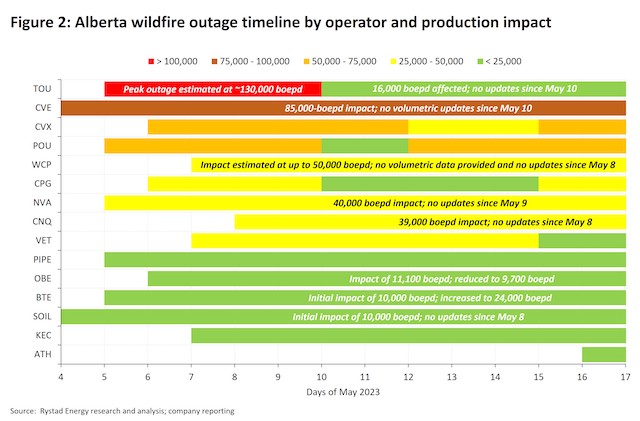
If we assume static outage volumes for these operators, a rough estimate could entail around 480,000 boepd in affected volumes for the peer group in Figure 2.
In any case, the situation remains dynamic and a large swathe of Alberta’s most productive shale plays – including the Montney, Duvernay, Spirit River, Clearwater, and Cardium – remain under ‘extreme’ or ‘very high’ wildfire threat (Figure 3).
Higher actual impacts are likewise supported by real-time field receipt data on TC Energy’s NGTL transmission system.
The most recent numbers indicate receipts of 11,725 million cubic feet per day (MMcfd), down from pre-wildfire receipts of nearly 13,500 MMcfd.
Although numbers are still above the lows observed on 6 May, current receipts imply an impact of 295,000 boepd on natural gas alone (Figure 4).


In British Columbia, the situation has likewise deteriorated, with evacuation orders issued for the 21,000 residents of Fort St. John, with OC wildfires burning at Stoddart Creek, Red Creek, Cameron River and Donnie Creek.
Current OC blazes are in closest proximity to Montney wells operated by ConocoPhillips, Arc Resources, and Pacific Canbriam.
Although no curtailments have yet been communicated, essentially all of the province’s 1.2 million boepd in Montney production is located in ‘extreme’ wildfire danger areas.
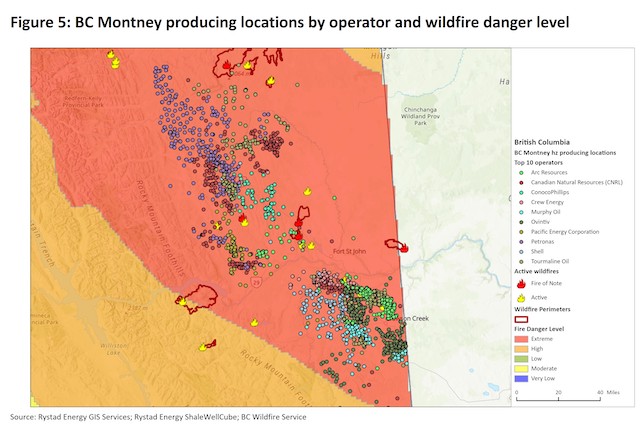
In northeastern Alberta – the locus of Canadian oil sands production – several fires are currently under control or being held.
Although there are currently no OC fires in the area, the lion’s share of Alberta’s oil sands projects currently falls with ‘extreme’ or ‘very high’ wildfire danger areas (Figure 6).
Over the past 24 hours, the greater Fort McMurray area has become enveloped in the ‘extreme’ wildfire classification, while nearly all producing thermal projects further south are within extreme wildfire conditions.
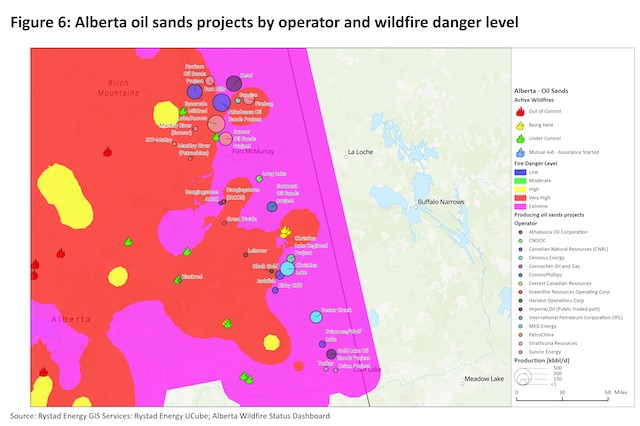
Rystad Energy estimates nearly 2.7 million bpd of Alberta oil sands production in May, which accounts for seasonal turnarounds and maintenance outages.
Of estimated May production volumes, approximately 60% are currently subject to extreme wildfire danger levels, with the remaining 40% subject to very high danger levels.
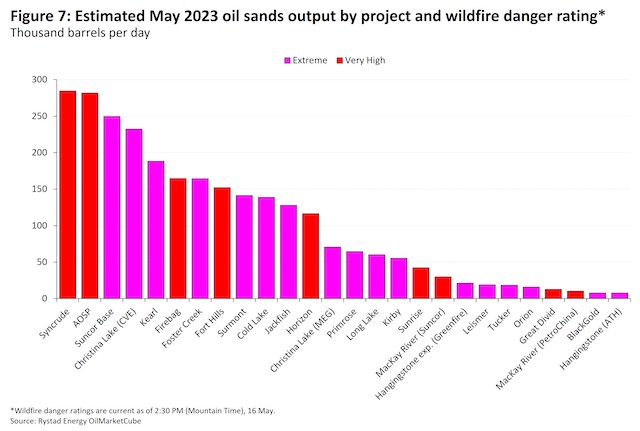




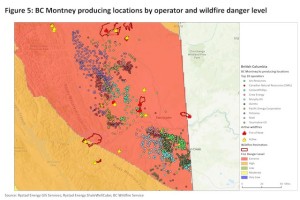
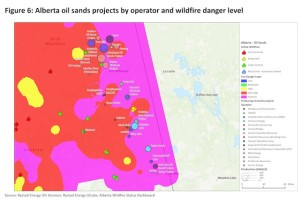
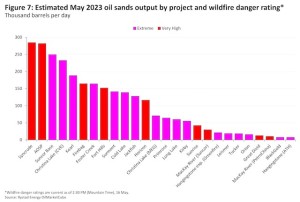
Follow us on social media: